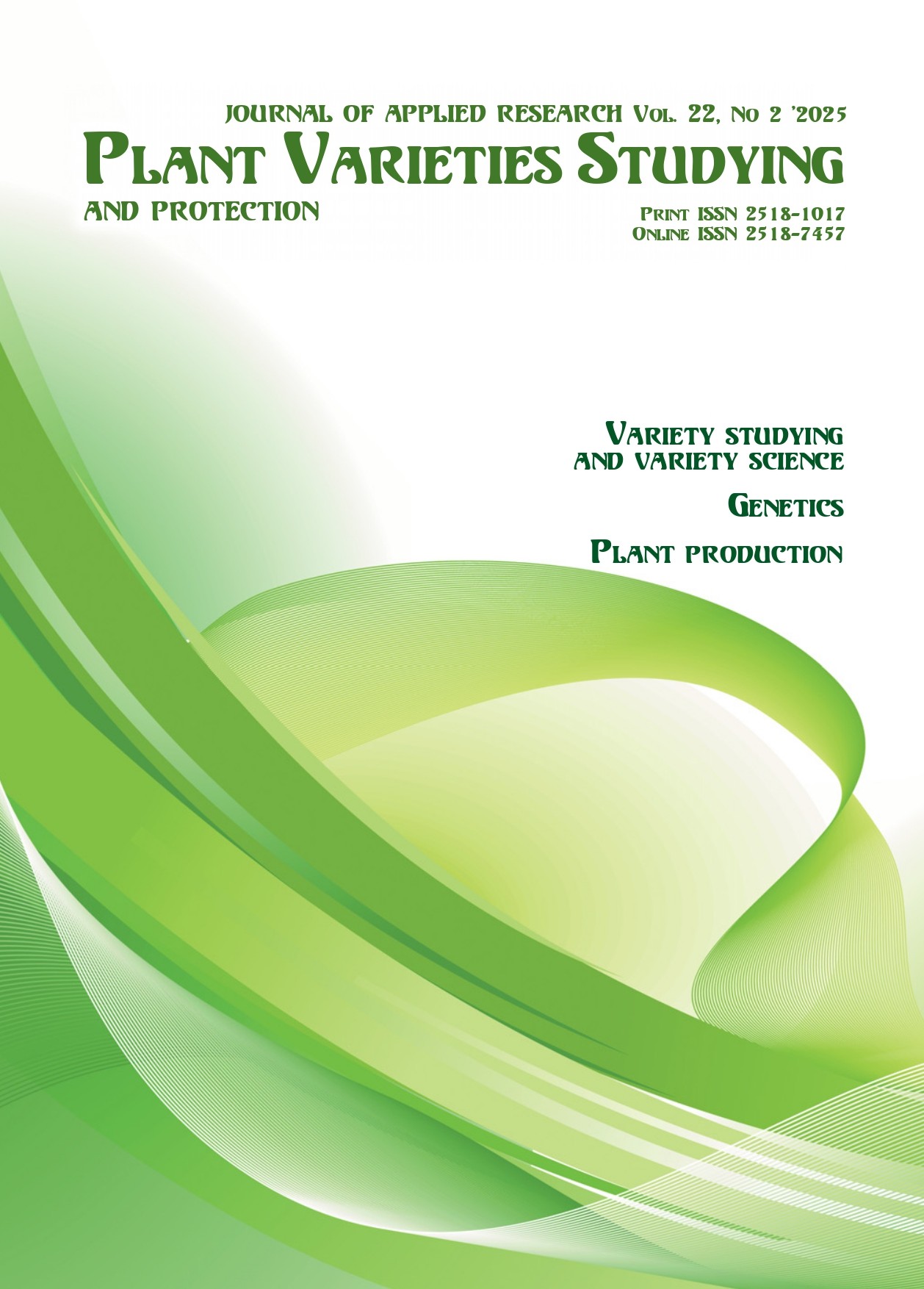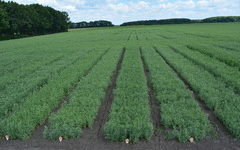Creation of source for marking and mapping of frost resistance QTL in winter barley
DOI:
https://doi.org/10.21498/2518-1017.21.2.2025.333451Keywords:
Hordeum vulgare L., recombinant inbred lines, microsatellite loci, PCR analysis, frost resistanceAbstract
Purpose. Creation the sets of recombinant-inbred lines for marking and mapping of frost resistance QTL in winter barley. Methods. Hybridization, artificial vernalization, growing plants under long-day conditions in phytotron light chambers and on a plot of land under natural daylight duration condition, DNA isolation with use CTAB-buffer, spectrophotometric determination of DNA concentration, polymerase chain reaction with direct primers, agarose and polyacrylamide gels electrophoresis, method of mathematical statistics chi-square test (χ2). Results. Using the SSD (single seed descent) method with maximum avoidance of selection, a set of 265 recombinant inbred lines F9 from the cross combination of the varieties ‘Khutorok’ / ‘Grabe’ was created, differing in the level of frost resistance, type of development and other traits. The creation of RIL from the crossing of the varieties ‘Akademichnyi’ / ‘Luran’ (170 lines F4) and ‘Tymofei’ / ‘Snihova Koroleva’ (145 lines F5) continues. The polymorphism of parental genotypes for the 14 microsatellite loci of chromosome 5H, including those localized in the region of the Fr-H1 and Fr-H2 key genes of the main frost resistance QTL. The allelic differences between parental varieties in several cross combinations were detected for a number of the studied microsatellite loci. The inheritance pattern of polymorphic microsatellite loci alleles in F1 hybrids from three cross combinations and individual plants from F2 populations ‘Akademichnyi’ / ‘Luran’ was investigated. Conclusions. The created RILs are suitable for use in barley genetic studies for identification, labeling, mapping of the main genes and QTL of qualitative and quantitative traits, primarily frost resistance. Polymorphic microsatellite loci were identified, which can be used for further analysis of recombinant-inbred lines, manipulation of genetic diversity, tracing inheritance and studying the effects of their alleles by the level of frost resistance and other traits of barley.
Downloads
References
Karsai, I., Hayes, P. M., Kling, J., Matus, I. A., Mészáros, K., Láng, L., Bedő, Z., & Sato, K. (2004). Genetic variation in component traits of heading date in Hordeum vulgare subsp. spontaneum accessions characterized in controlled environments. Crop Science, 44(5), 1622–1632. https://doi.org/10.2135/cropsci2004.1622

von Zitzewitz, J., Szűcs, P., Dubcovsky, J., Yan, L., Francia, E., Pecchioni, N., Casas, A., Chen, T. H. H., Hayes, P. M., & Skinner, J. S. (2005). Molecular and structural characterization of barley vernalization genes. Plant Molecular Biology, 59(3), 449–467. https://doi.org/10.1007/s11103-005-0351-2
 |
| 
Stelmakh, A. F., Balvinska, M. S., Fayt, V. I., & Zacharova, O. O. (2017). Evaluation of systems regulating initial development rate in barley (Hordeum vulgare L.) of autumn sowing. Collected Scientific Articles Plant Breeding and Genetics Institute – National Center of Seed and Cultivars Investigation, 29, 50–59. [In Ukrainian]
Linchevs’kyj, A., & Legkun, I. (2020). A new attitude to barley culture and selection in the conditions of climate change. Bulletin of Agricultural Science, 98(9), 34–42. https://doi.org/10.31073/agrovisnyk202009-05 [In Ukrainian]
Demydov, O. A., Hudzenko, V. M., & Vasylkivskyi, S. P. (2016). Impact of weather conditions during the growing season on winter barley yield in the Forest-Steppe zone of Ukraine. Plant Varieties Studying and Protection, 4, 39–43. https://doi.org/10.21498/2518-1017.4(33).2016.88670 [In Ukrainian]
Visioni, A., Tondelli, A., Francia, E., Pswarayi, A., Malosetti, M., Russell, J., Thomas, W., Waugh, R., Pecchioni, N., Romagosa, I., & Comadran, J. (2013). Genome-wide association mapping of frost tolerance in barley (Hordeum vulgare L.). BMC Genomics, 14(1), Article 424. https://doi.org/10.1186/1471-2164-14-424
 |
| 
Ahres, M., Gierczik, K., Boldizsár, Á., Vítámvás, P., & Galiba, G. (2020). Temperature and light-quality-dependent regulation of freezing tolerance in barley. Plants, 9(1), Article 83. https://doi.org/10.3390/plants9010083
 |
| 
Zavalypich, N. O. (2019). Features of wintering of winter barley plants, depending on the timing of sowing in the Northern Steppe of Ukraine. Grain Crops, 3(2), 312–317. https://doi.org/10.31867/2523-4544/0091
Petcu, E., Þerbea, M., Duþã, Z., & Ionescu, D. (2000). Study on the relationship between frost resistance and free proline content in some winter wheat and barley genotypes. Romanian Agricultural Research, 13–14, 37–41.
Gut, M., Bichoński, A., & Węgrzyn, S. (2004). Heritability, variation and relationship between frost resistance of winter barley and some of its characters. Electronic Journal of Polish Agricultural Universities, 7(1), Article 02. http://www.ejpau.media.pl/volume7/issue1/agronomy/art-02.html
Liang, X., Hu, G., McDougall, L., Werth, J., Yang, R., Yang, J., Evans, C., & Satterfield, K. (2024). Small stomates and xylem vessels associated with freeze tolerance in winter barley. Journal of Agronomy and Crop Science, 210(4), Article e12737. https://doi.org/10.1111/jac.12737

Linchevskyi, А. А., Legkun, І. B., Babash, А. B., & Shcherbyna, Z. V. (2017). Priorities of barley (Hordeum vulgare L.) breeding for modern conditions of grain production in Ukraine. Collected Scientific Articles Plant Breeding and Genetics Institute – National Center of Seed and Cultivars Investigation, 30, 23–39. [In Ukrainian]
Yarmolska, O. Ye., Feoktistov, P. O., & Gavrilov, S. V. (2022). Formation of frost resistance of barley plants with different types of rosettes during hardening on different photoperiods. Agrarian Innovations, 13, 167–172 https://doi.org/10.32848/agrar.innov.2022.13.25 [In Ukrainian]
Kato, K. (1992). Ecological and genetic studies on heading time and its constituent traits in wheat. Memoirs of the Faculty of the Agriculture, Kochi University, 39, 1–58.
Ternovskaya, T. K., & Vdovichenko, Zh. V. (2003). Dependence of genetic analysis results in self-pollinating cereal species on the nature of the mapping population. Cytology and Genetics, 3, 67–79.
Rollins, J. A., Drosse, B., Mulki, M. A., Grando, S., Baum, M., Singh, M., Ceccarelli, S., & von Korff, M. (2013). Variation at the vernalisation genes Vrn-H1 and Vrn-H2 determines growth and yield stability in barley (Hordeum vulgare) grown under dryland conditions in Syria. Theoretical and Applied Genetics, 126(11), 2803–2824. https://doi.org/10.1007/s00122-013-2173-y
 |
| 
Saisho, D., Ishii, M., Hori, K., & Sato, K. (2011). Natural variation of barley vernalization requirements: implication of quantitative variation of winter growth habit as an adaptive trait in East Asia. Plant and Cell Physiology, 52(5), 775–784. https://doi.org/10.1093/pcp/pcr046
 |
| 
Shahinnia, F., Rezai, A., Sayed-Tabatabaei, B. E., Komatsuda, T., & Mohammadi, S. A. (2006). QTL mapping of heading date and plant height in barley cross “Azumamugi” × “Kanto Nakate Gold”. Iranian Journal of Biotechnology, 4(2), 88–94. https://www.ijbiotech.com/article_6982.html
Mikołajczak, K., Ogrodowicz, P., Gudyś, K., Krystkowiak, K., Sawikowska, A., Frohmberg, W., Górny, A., Kędziora, A., Jankowiak, J., Józefczyk, D., Karg, G., Andrusiak, J., Krajewski, P., Szarejko, I., Surma, M., Adamski, T., Guzy-Wróbelska, J., & Kuczyńska, A. (2016). Quantitative trait loci for yield and yield-related traits in spring barley populations derived from crosses between European and Syrian cultivars. PLOS ONE, 11(5), Article e0155938. https://doi.org/10.1371/journal.pone.0155938
 |
| 
Ogrodowicz, P., Kuczyńska, A., Mikołajczak, K., Adamski, T., Surma, M., Krajewski, P., Ćwiek-Kupczyńska, H., Kempa, M., Rokicki, M., & Jasińska, D. (2020). Mapping of quantitative trait loci for traits linked to fusarium head blight in barley. PLOS ONE, 15(2), Article e0222375. https://doi.org/10.1371/journal.pone.0222375
 |
| 
Ajayi, O. O., Bregitzer, P., Klos, K., Hu, G., Walling, J. G., & Mahalingam, R. (2023). QTL mapping of shoot and seed traits impacted by drought in barley using a recombinant inbred line population. BMC Plant Biology, 23(1), Article 283. https://doi.org/10.1186/s12870-023-04292-x
 |
| 
Mikołajczak, K., Ogrodowicz, P., Ćwiek-Kupczyńska, H., Weigelt-Fischer, K., Mothukuri, S. R., Junker, A., Altmann, T., Krystkowiak, K., Adamski, T., Surma, M., Kuczyńska, A., & Krajewski, P. (2020). Image phenotyping of spring barley (Hordeum vulgare L.) RIL population under drought: selection of traits and biological interpretation. Frontiers in Plant Science, 11, Article 743. https://doi.org/10.3389/fpls.2020.00743
 |
| 
Cabeza, A., Casas, A. M., Pérez-Torres, A., Ciudad, F. J., & Igartua, E. (2025). Root system architecture in a barley RIL population: Agronomic effects of seedling and adult root traits. Field Crops Research, 324, Article 109806. https://doi.org/10.1016/j.fcr.2025.109806

Bregitzer, P., Ajayi, O., Gao, D., Esvelt Klos, K., & Mahalingam, R. (2023). Registration of Golden Promise/Otis barley recombinant inbred line mapping population. Journal of Plant Registrations, 18(1), 197–203. https://doi.org/10.1002/plr2.20337

Balvinska, M. S., Volkova, N. E., Kolesnyk, O. O., Solodenko, A. Ye., & Chebotar, S. V. (2015). Differentiation, Identification, Determination of Typicity and Hybrid Status of Agricultural Crops by DNA Profiling: Methodical Recommendations. Astroprynt. [In Ukrainian]
Varshney, R. K., Marcel, T. C., Ramsay, L., Russell, J., Röder, M. S., Stein, N., Waugh, R., Langridge, P., Niks, R. E., & Graner, A. (2007). A high density barley microsatellite consensus map with 775 SSR loci. Theoretical and Applied Genetics, 114(6), 1091–1103. https://doi.org/10.1007/s00122-007-0503-7
 |
| 
Hearnden, P. R., Eckermann, P. J., McMichael, G. L., Hayden, M. J., Eglinton, J. K., & Chalmers, K. J. (2007). A genetic map of 1,000 SSR and DArT markers in a wide barley cross. Theoretical and Applied Genetics, 115(3), 383–391. https://doi.org/10.1007/s00122-007-0572-7
 |
| 
Balvinska, M. S., Naguliak, O. I., & Fayt, V. I. (2020). Polymorphism and selection of barley frost-resistant genotypes of autumn-sown barley by DNA markers of chromosome 5H. The Bulletin of Kharkiv National Agrarian University. Series Biology, 3, 87–97. https://doi.org/10.35550/vbio2020.03.087 [In Ukrainian]
Stelmakh, A. F., Fait, V. I., & Pohrebniuk, O. O. (2009). Development of recombinant inbred line sets in winter bread wheat. Collected Scientific Articles Plant Breeding and Genetics Institute – National Center of Seed and Cultivars Investigation, 14, 9–18. [In Ukrainian]
Rapacz, M., Tyrka, M., Gut, M., & Mikulski, W. (2010). Associations of PCR markers with freezing tolerance and photosynthetic acclimation to cold in winter barley. Euphytica, 175(3), 293–301. https://doi.org/10.1007/s10681-010-0127-x

Published
How to Cite
Issue
Section
License
Copyright (c) 2025 V. I. Fait, M. S. Balvinska, P. O. Feoktistov, S. V. Havrylov, V. R. Fedorova

This work is licensed under a Creative Commons Attribution-ShareAlike 4.0 International License.
Starting in 2022, the copyright to the publication remains with the authors
Our journal abides by the CREATIVE COMMONS copyright rights and permissions for open access journals.
Authors, who are published in this journal, agree to the following conditions:
- The authors reserve the right to authorship of the work and pass the first publication right of this work to the journal under the terms of a Creative Commons Attribution License, which allows others to freely distribute the published research with the obligatory reference to the authors of the original work and the first publication of the work in this journal.
- The authors have the right to conclude separate supplement agreements that relate to non-exclusive work distribution in the form in which it has been published by the journal (for example, to upload the work to the online storage of the journal or publish it as part of a monograph), provided that the reference to the first publication of the work in this journal is included.

























 Ukrainian Institute for Plant Varieties Examination
Ukrainian Institute for Plant Varieties Examination  Селекційно-генетичний інститут
Селекційно-генетичний інститут Institute of Plant Physiology and Genetics of the National Academy of Sciences of Ukraine
Institute of Plant Physiology and Genetics of the National Academy of Sciences of Ukraine
 The National Academy of Agrarian Sciences of Ukraine
The National Academy of Agrarian Sciences of Ukraine